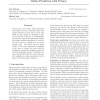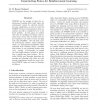122
Voted
ICML
2010
IEEE
14 years 10 months ago
2010
IEEE
This paper proposes a new method for comparing clusterings both partitionally and geometrically. Our approach is motivated by the following observation: the vast majority of previ...
102
Voted
ICML
2010
IEEE
14 years 10 months ago
2010
IEEE
In this paper, we consider online prediction from expert advice in a situation where each expert observes its own loss at each time while the loss cannot be disclosed to others fo...
137
Voted
ICML
2010
IEEE
14 years 10 months ago
2010
IEEE
In the realm of multilabel classification (MLC), it has become an opinio communis that optimal predictive performance can only be achieved by learners that explicitly take label d...
108
click to vote
ICML
2010
IEEE
14 years 10 months ago
2010
IEEE
Many real-world datasets can be clustered along multiple dimensions. For example, text documents can be clustered not only by topic, but also by the author's gender or sentim...
114
Voted
ICML
2010
IEEE
14 years 10 months ago
2010
IEEE
Most learning to rank research has assumed that the utility of different documents is independent, which results in learned ranking functions that return redundant results. The fe...
132
Voted
ICML
2010
IEEE
14 years 10 months ago
2010
IEEE
Matrix factorization into the product of lowrank matrices induces non-identifiability, i.e., the mapping between the target matrix and factorized matrices is not one-to-one. In th...
104
click to vote
ICML
2010
IEEE
14 years 10 months ago
2010
IEEE
POMDPs are the models of choice for reinforcement learning (RL) tasks where the environment cannot be observed directly. In many applications we need to learn the POMDP structure ...
131
click to vote
ICML
2010
IEEE
14 years 10 months ago
2010
IEEE
We introduce into the classical Perceptron algorithm with margin a mechanism of unlearning which in the course of the regular update allows for a reduction of possible contributio...
114
Voted
ICML
2010
IEEE
14 years 10 months ago
2010
IEEE
Temporal difference (TD) algorithms are attractive for reinforcement learning due to their ease-of-implementation and use of "bootstrapped" return estimates to make effi...



